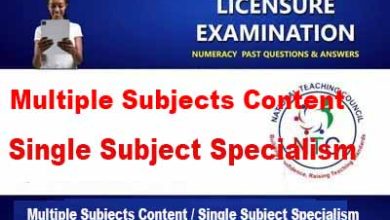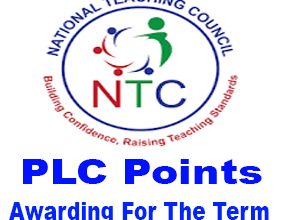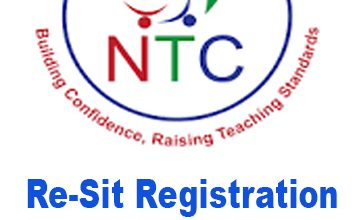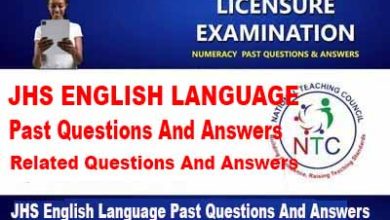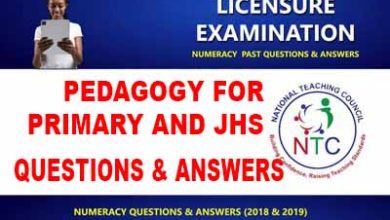NTC Professional General Knowledge Past Questions and Answers (NUMERACY)
NTC Professional General Knowledge Past Questions and Answers (NUMERACY)
The Professional General Knowledge aspect consist of three sections thus (Literacy, Numeracy and Essential Skills)
Here are the most related all questions and answer that may come from the Professional General Knowledge exams
JOIN NTC EXAMS HERE
NTC Pedagogy For Primary And JHS Questions And Answers (Motivation And Assessment)
NTC Pedagogy For Primary And JHS Questions And Answers(Questioning and Feedback)
NTC Pedagogy For Primary And JHS Questions And Answers(Classroom Management)
NTC Pedagogy For Primary And JHS Questions And Answers (Lesson Planning)
NTC Pedagogy For Primary And JHS Questions And Answers (Inclusion Learning)
NTC Pedagogy For Primary And JHS Questions And Answers (Differentiated And Scaffolding)
NTC Pedagogy For Primary And JHS Questions And Answers (Curriculum)
NTC Pedagogy For Primary And JHS Questions And Answers (Methods Of Teaching Primary And JHS) 1
NTC Pedagogy For Primary And JHS Questions And Answers (Methods Of Teaching Primary And JHS) 2
JOIN OUR WHATSAPP GROUP HERE
QUESTIONS AND ANSWERS ON NUMERACY
- How much water is used from a tank containing 500 liters if 3/5 of it is used?
a) 200 liters
b) 300 liters
c) 350 liters
d) 400 liters
Answer: b) 300 liters
2. A reservoir contains 8000 liters of water. If 25% of the water is used, how much remains?
a) 2000 liters
b) 4000 liters
c) 6000 liters
d) 800 liters
Answer: b) 4000 liters
3. If 7/10 of a swimming pool’s water is drained, what percentage of water remains?
a) 10%
b) 20%
c) 30%
d) 70%
Answer: c) 30%
4. A water tank contains 600 liters. If 40 liters are used daily, how many days will the water last?
a) 12 days
b) 15 days
c) 20 days
d) 25 days
Answer: b) 15 days
5. In a household, 1/4 of the daily water usage goes for drinking and cooking. If they consume 60 liters daily, how much water is used for drinking and cooking?
a) 10 liters
b) 15 liters
c) 20 liters
d) 25 liters
Answer: c) 20 liters
NTC Pedagogy For Primary And JHS Questions And Answers (Motivation And Assessment)
NTC Pedagogy For Primary And JHS Questions And Answers(Questioning and Feedback)
NTC Pedagogy For Primary And JHS Questions And Answers(Classroom Management)
NTC Pedagogy For Primary And JHS Questions And Answers (Lesson Planning)
NTC Pedagogy For Primary And JHS Questions And Answers (Inclusion Learning)
NTC Pedagogy For Primary And JHS Questions And Answers (Differentiated And Scaffolding)
NTC Pedagogy For Primary And JHS Questions And Answers (Curriculum)
NTC Pedagogy For Primary And JHS Questions And Answers (Methods Of Teaching Primary And JHS) 1
NTC Pedagogy For Primary And JHS Questions And Answers (Methods Of Teaching Primary And JHS) 2
JOIN OUR WHATSAPP GROUP HERE
6. A water tank has 1000 liters of water. If 3/8 of the water is used for gardening, how much water is left in the tank?
a) 375 liters
b) 450 liters
c) 625 liters
d) 625 liters
Answer: c) 625 liters
7. If a factory uses 15% of its water daily, how much water is consumed if the daily usage is 12000 liters?
a) 1000 liters
b) 1800 liters
c) 1500 liters
d) 2000 liters
Answer: b) 1800 liters
8. A water tank is filled to its full capacity with 900 liters. If 1/5 of the water leaks, how much water remains?
a) 180 liters
b) 360 liters
c) 720 liters
d) 450 liters
Answer: d) 450 liters
9. A swimming pool contains 20000 liters of water. If 20% of the water evaporates during the summer, how much water remains in the pool?
a) 5000 liters
b) 8000 liters
c) 10000 liters
d) 16000 liters
Answer: b) 8000 liters
10. If 2/3 of a water reservoir is full, what percentage of water is missing?
a) 15%
b) 25%
c) 33.33%
d) 50%
Answer: c) 33.33%
NTC Pedagogy For Primary And JHS Questions And Answers (Motivation And Assessment)
NTC Pedagogy For Primary And JHS Questions And Answers(Questioning and Feedback)
NTC Pedagogy For Primary And JHS Questions And Answers(Classroom Management)
NTC Pedagogy For Primary And JHS Questions And Answers (Lesson Planning)
NTC Pedagogy For Primary And JHS Questions And Answers (Inclusion Learning)
NTC Pedagogy For Primary And JHS Questions And Answers (Differentiated And Scaffolding)
NTC Pedagogy For Primary And JHS Questions And Answers (Curriculum)
NTC Pedagogy For Primary And JHS Questions And Answers (Methods Of Teaching Primary And JHS) 1
NTC Pedagogy For Primary And JHS Questions And Answers (Methods Of Teaching Primary And JHS) 2
JOIN OUR WHATSAPP GROUP HERE
11. A household uses 50 liters of water daily. If this consumption remains constant, how much water will they use in 30 days?
a) 1200 liters
b) 1500 liters
c) 2000 liters
d) 2500 liters
Answer: b) 1500 liters
12. A water tank has 800 liters of water. If 20% of the water is used for cleaning, how much water is used for cleaning?
a) 80 liters
b) 120 liters
c) 160 liters
d) 200 liters
Answer: c) 160 liters
13. In a water conservation campaign, a community reduces their water usage by 15%. If they were using 4000 liters before, how much water are they using now?
a) 600 liters
b) 1600 liters
c) 3400 liters
d) 34000 liters
Answer: c) 3400 liters
14. If a water tank is filled to 2/7 of its capacity, what percentage of the water tank is empty?
a) 28.57%
b) 42.86%
c) 57.14%
d) 71.43%
Answer: b) 42.86%
15. A company uses 3000 liters of water daily. If they decide to reduce their water usage by 25%, how much water will they use after the reduction?
a) 500 liters
b) 1500 liters
c) 2250 liters
d) 2500 liters
Answer: b) 1500 liters
NTC Pedagogy For Primary And JHS Questions And Answers (Motivation And Assessment)
NTC Pedagogy For Primary And JHS Questions And Answers(Questioning and Feedback)
NTC Pedagogy For Primary And JHS Questions And Answers(Classroom Management)
NTC Pedagogy For Primary And JHS Questions And Answers (Lesson Planning)
NTC Pedagogy For Primary And JHS Questions And Answers (Inclusion Learning)
NTC Pedagogy For Primary And JHS Questions And Answers (Differentiated And Scaffolding)
NTC Pedagogy For Primary And JHS Questions And Answers (Curriculum)
NTC Pedagogy For Primary And JHS Questions And Answers (Methods Of Teaching Primary And JHS) 1
NTC Pedagogy For Primary And JHS Questions And Answers (Methods Of Teaching Primary And JHS) 2
JOIN OUR WHATSAPP GROUP HERE
16. If a water reservoir is 80% full, what percentage of water is still available to be filled?
a) 10%
b) 20%
c) 30%
d) 80%
Answer: c) 30%
17. A water tank contains 600 liters. If 60 liters are used daily, how many liters will remain after 10 days?
a) 0 liters
b) 100 liters
c) 300 liters
d) 540 liters
Answer: c) 300 liters
18. In a drought-affected area, a village uses 10,000 liters of water daily. If they need to reduce usage by 40%, how much water should they use now?
a) 2000 liters
b) 4000 liters
c) 6000 liters
d) 8000 liters
Answer: b) 4000 liters
19. A water tank is filled to 90% of its capacity. How much more water can be added to fill it completely?
a) 10%
b) 50%
c) 90%
d) 100%
Answer: a) 10%
20. If a household uses 50 liters of water daily, how much water will they use in one year (365 days)?
a) 5000 liters
b) 10000 liters
c) 15000 liters
d) 18250 liters
Answer: d) 18250 liters
NTC Pedagogy For Primary And JHS Questions And Answers (Motivation And Assessment)
NTC Pedagogy For Primary And JHS Questions And Answers(Questioning and Feedback)
NTC Pedagogy For Primary And JHS Questions And Answers(Classroom Management)
NTC Pedagogy For Primary And JHS Questions And Answers (Lesson Planning)
NTC Pedagogy For Primary And JHS Questions And Answers (Inclusion Learning)
NTC Pedagogy For Primary And JHS Questions And Answers (Differentiated And Scaffolding)
NTC Pedagogy For Primary And JHS Questions And Answers (Curriculum)
NTC Pedagogy For Primary And JHS Questions And Answers (Methods Of Teaching Primary And JHS) 1
NTC Pedagogy For Primary And JHS Questions And Answers (Methods Of Teaching Primary And JHS) 2
JOIN OUR WHATSAPP GROUP HERE
21. How many oranges are there in the basket?
a) 10
b) 20
c) 30 (Answer)
d) 40
22. What is the cost of each orange?
a) GH¢0.20
b) GH¢0.30
c) GH¢0.40
d) GH¢0.50 (Answer)
23. What is the total cost of the oranges?
a) GH¢5
b) GH¢10
c) GH¢15 (Answer)
d) GH¢20
24. If the number of oranges in the basket increased to 40, what would be the new total cost?
a) GH¢10
b) GH¢15 (Answer)
c) GH¢20
d) GH¢25
25. If the cost of each orange was GH¢0.75, what would be the total cost of the oranges?
a) GH¢10.50
b) GH¢15 (Answer)
c) GH¢22.50
d) GH¢25
26. What is the cost of 10 oranges?
a) GH¢5
b) GH¢7.50 (Answer)
c) GH¢10
d) GH¢12.50
27. If two oranges were removed from the basket, how much would be the new total cost?
a) GH¢7.50
b) GH¢12.50
c) GH¢14.50
d) GH¢15 (Answer)
28. What is the average cost per orange?
a) GH¢0.25
b) GH¢0.30
c) GH¢0.40
d) GH¢0.50 (Answer)
NTC Pedagogy For Primary And JHS Questions And Answers (Motivation And Assessment)
NTC Pedagogy For Primary And JHS Questions And Answers(Questioning and Feedback)
NTC Pedagogy For Primary And JHS Questions And Answers(Classroom Management)
NTC Pedagogy For Primary And JHS Questions And Answers (Lesson Planning)
NTC Pedagogy For Primary And JHS Questions And Answers (Inclusion Learning)
NTC Pedagogy For Primary And JHS Questions And Answers (Differentiated And Scaffolding)
NTC Pedagogy For Primary And JHS Questions And Answers (Curriculum)
NTC Pedagogy For Primary And JHS Questions And Answers (Methods Of Teaching Primary And JHS) 1
NTC Pedagogy For Primary And JHS Questions And Answers (Methods Of Teaching Primary And JHS) 2
JOIN OUR WHATSAPP GROUP HERE
29. If the cost of each orange increased by GH¢0.20, what would be the new total cost for 30 oranges?
a) GH¢5
b) GH¢10
c) GH¢15 (Answer)
d) GH¢20
30. What is the total cost if half of the oranges were given away for free?
a) GH¢5
b) GH¢7.50
c) GH¢10
d) GH¢15 (Answer)
31. If the basket contains 40 oranges and each orange costs GH¢0.75, what is the new total cost?
a) GH¢25
b) GH¢30 (Answer)
c) GH¢35
d) GH¢40
32. If 20 oranges were added to the basket, how much would be the new total cost?
a) GH¢5
b) GH¢10
c) GH¢15 (Answer)
d) GH¢20
33. What is the total cost if the price of each orange is reduced by GH¢0.10?
a) GH¢4
b) GH¢11
c) GH¢12 (Answer)
d) GH¢14
34. If the cost of each orange doubled, what would be the new total cost for 30 oranges?
a) GH¢15
b) GH¢30 (Answer)
c) GH¢45
d) GH¢60
35. If the basket contains 25 oranges and each orange costs GH¢0.60, what is the total cost of the oranges?
a) GH¢15
b) GH¢18 (Answer)
c) GH¢20
d) GH¢22.50
36, Jane has twice as many apples as Tom. If Tom has ‘x’ apples, how many apples does Jane have?
A) 2x
B) 3x
C) x + 2
D) x / 2
Answer: A) 2x
NTC Pedagogy For Primary And JHS Questions And Answers (Motivation And Assessment)
NTC Pedagogy For Primary And JHS Questions And Answers(Questioning and Feedback)
NTC Pedagogy For Primary And JHS Questions And Answers(Classroom Management)
NTC Pedagogy For Primary And JHS Questions And Answers (Lesson Planning)
NTC Pedagogy For Primary And JHS Questions And Answers (Inclusion Learning)
NTC Pedagogy For Primary And JHS Questions And Answers (Differentiated And Scaffolding)
NTC Pedagogy For Primary And JHS Questions And Answers (Curriculum)
NTC Pedagogy For Primary And JHS Questions And Answers (Methods Of Teaching Primary And JHS) 1
NTC Pedagogy For Primary And JHS Questions And Answers (Methods Of Teaching Primary And JHS) 2
JOIN OUR WHATSAPP GROUP HERE
37. The perimeter of a square garden is 36 meters. What is the length of each side of the square?
A) 6 meters
B) 9 meters
C) 12 meters
D) 18 meters
Answer: B) 9 meters
38. The sum of two consecutive even numbers is 50. What are the numbers?
A) 24, 26
B) 25, 27
C) 20, 22
D) 22, 24
Answer: A) 24, 26
39. A toy store sells teddy bears for $10 each. If ‘x’ is the number of teddy bears purchased, what is the total cost?
A) $10 + x
B) 10x
C) 10 – x
D) 10 / x
Answer: B) 10x
40. The area of a rectangle is ‘A’ square units, and its length is ‘x + 3’ units. What is the width of the rectangle?
A) x + A
B) A / (x + 3)
C) x – 3
D) A – 3
Answer: B) A / (x + 3)
41. If the sum of two numbers is 25, and one number is ‘x,’ what is the other number?
A) 25 + x
B) 25 – x
C) 25 * x
D) x / 25
Answer: B) 25 – x
42. The temperature in degrees Celsius, ‘C,’ can be converted to Fahrenheit, ‘F,’ using the formula F = (9/5)C + 32. What is the Fahrenheit temperature if it is 20 degrees Celsius?
A) 36°F
B) 54°F
C) 68°F
D) 72°F
Answer: C) 68°F
NTC Pedagogy For Primary And JHS Questions And Answers (Motivation And Assessment)
NTC Pedagogy For Primary And JHS Questions And Answers(Questioning and Feedback)
NTC Pedagogy For Primary And JHS Questions And Answers(Classroom Management)
NTC Pedagogy For Primary And JHS Questions And Answers (Lesson Planning)
NTC Pedagogy For Primary And JHS Questions And Answers (Inclusion Learning)
NTC Pedagogy For Primary And JHS Questions And Answers (Differentiated And Scaffolding)
NTC Pedagogy For Primary And JHS Questions And Answers (Curriculum)
NTC Pedagogy For Primary And JHS Questions And Answers (Methods Of Teaching Primary And JHS) 1
NTC Pedagogy For Primary And JHS Questions And Answers (Methods Of Teaching Primary And JHS) 2
JOIN OUR WHATSAPP GROUP HERE
43. A car rental company charges $40 per day for renting a car and an additional $20 per day for insurance. If ‘x’ is the number of days a car is rented, what is the total cost, including insurance?
A) 40x + 20
B) 60x
C) 20x + 40
D) 40 + 20x
Answer: D) 40 + 20x
44. The length of a rectangle is 4 meters more than twice its width. If the width is ‘w’ meters, what is the length of the rectangle?
A) 2w – 4
B) 2w + 4
C) 4w
D) 4w + 2
Answer: B) 2w + 4
45. The sum of three consecutive odd integers is 45. What are the integers?
A) 13, 15, 17
B) 15, 17, 19
C) 9, 11, 13
D) 11, 13, 15
Answer: D) 11, 13, 15
46. The perimeter of a rectangle is 26 meters. If the width is ‘x’ meters and the length is ‘x + 5’ meters, what are the dimensions of the rectangle?
A) 6m and 11m
B) 6m and 5m
C) 8m and 11m
D) 8m and 5m
Answer: A) 6m and 11m
47. The cost of a book is $15, and it is on sale for 20% off. What is the sale price of the book?
A) $12
B) $10
C) $13
D) $9
Answer: C) $13
NTC Pedagogy For Primary And JHS Questions And Answers (Motivation And Assessment)
NTC Pedagogy For Primary And JHS Questions And Answers(Questioning and Feedback)
NTC Pedagogy For Primary And JHS Questions And Answers(Classroom Management)
NTC Pedagogy For Primary And JHS Questions And Answers (Lesson Planning)
NTC Pedagogy For Primary And JHS Questions And Answers (Inclusion Learning)
NTC Pedagogy For Primary And JHS Questions And Answers (Differentiated And Scaffolding)
NTC Pedagogy For Primary And JHS Questions And Answers (Curriculum)
NTC Pedagogy For Primary And JHS Questions And Answers (Methods Of Teaching Primary And JHS) 1
NTC Pedagogy For Primary And JHS Questions And Answers (Methods Of Teaching Primary And JHS) 2
JOIN OUR WHATSAPP GROUP HERE
48. The area of a square is ‘A’ square meters. What is the length of each side of the square?
A) √A
B) A / 4
C) A / 2
D) √(A / 2)
Answer: A) √A
49. The sum of two numbers is 40, and their difference is 8. What are the two numbers?
A) 24 and 16
B) 26 and 14
C) 22 and 18
D) 30 and 10
Answer: C) 22 and 18
50. The cost of ‘x’ pens is $24, and the cost of ‘y’ pencils is $18. What is the total cost if you buy ‘x’ pens and ‘y’ pencils?
A) $42
B) $18x + 24y
C) $18 + 24
D) $42xy
Answer: B) $18x + 24y
51. The height of a triangle is 5 cm more than twice its base. If the base is ‘b’ cm, what is the height of the triangle?
A) b + 2
B) 2b – 5
C) 2b + 5
D) b – 2
Answer: C) 2b + 5
52. The sum of two consecutive integers is 47. What are the integers?
A) 23 and 24
B) 24 and 25
C) 22 and 23
D) 25 and 26
Answer: C) 22 and 23
NTC Pedagogy For Primary And JHS Questions And Answers (Motivation And Assessment)
NTC Pedagogy For Primary And JHS Questions And Answers(Questioning and Feedback)
NTC Pedagogy For Primary And JHS Questions And Answers(Classroom Management)
NTC Pedagogy For Primary And JHS Questions And Answers (Lesson Planning)
NTC Pedagogy For Primary And JHS Questions And Answers (Inclusion Learning)
NTC Pedagogy For Primary And JHS Questions And Answers (Differentiated And Scaffolding)
NTC Pedagogy For Primary And JHS Questions And Answers (Curriculum)
NTC Pedagogy For Primary And JHS Questions And Answers (Methods Of Teaching Primary And JHS) 1
NTC Pedagogy For Primary And JHS Questions And Answers (Methods Of Teaching Primary And JHS) 2
JOIN OUR WHATSAPP GROUP HERE
53. The area of a triangle is 36 square centimeters, and its height is ‘h’ centimeters. What is the length of the base?
A) 18/h
B) h/18
C) √(36h)
D) 2h
Answer: A) 18/h
54. A company produces ‘x’ widgets per day, and each widget sells for $8. What is the total revenue if ‘x’ widgets are sold in a day?
A) 8x
B) x + 8
C) 8 – x
D) 8 / x
Answer: A) 8x
55. The sum of two consecutive odd integers is 58. What are the integers?
A) 27 and 31
B) 28 and 30
C) 29 and 31
D) 26 and 30
Answer: C) 29 and 31
NTC Pedagogy For Primary And JHS Questions And Answers (Motivation And Assessment)
NTC Pedagogy For Primary And JHS Questions And Answers(Questioning and Feedback)
NTC Pedagogy For Primary And JHS Questions And Answers(Classroom Management)
NTC Pedagogy For Primary And JHS Questions And Answers (Lesson Planning)
NTC Pedagogy For Primary And JHS Questions And Answers (Inclusion Learning)
NTC Pedagogy For Primary And JHS Questions And Answers (Differentiated And Scaffolding)
NTC Pedagogy For Primary And JHS Questions And Answers (Curriculum)
NTC Pedagogy For Primary And JHS Questions And Answers (Methods Of Teaching Primary And JHS) 1
NTC Pedagogy For Primary And JHS Questions And Answers (Methods Of Teaching Primary And JHS) 2
JOIN OUR WHATSAPP GROUP HERE

